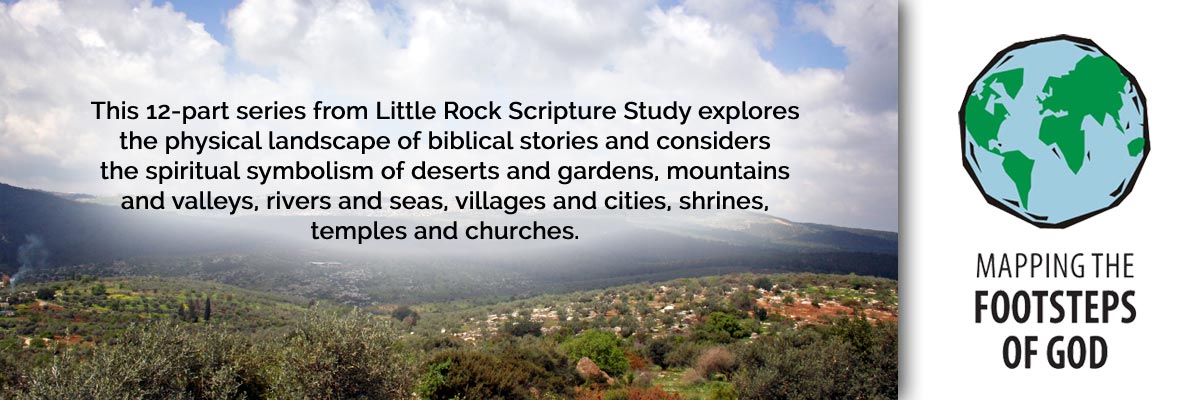Official Website of the
Catholic Diocese of Little Rock
Biblical gardens reveal God's plans for us
Published: March 22, 2014
This is the third column in a 12-part series
By Cackie Upchurch
Director of Little Rock Scripture Study
According to the first chapter of Genesis, God's first creative act was to bring order out of chaos, to assign a place for all things and then to fill those places. In the second chapter of Genesis, we find another creation account, "The Lord God planted a garden in Eden ..."
 Gardeners the world over will appreciate that both biblical creation stories depict God outfitted for working in the dirt, so to speak! So idyllic is this original garden setting that God is said to be "walking about in the garden at the breezy time of the day" (Genesis 3:8).
Gardeners the world over will appreciate that both biblical creation stories depict God outfitted for working in the dirt, so to speak! So idyllic is this original garden setting that God is said to be "walking about in the garden at the breezy time of the day" (Genesis 3:8).
But, in Scripture, the garden is not just the placid setting as in the early chapters of Genesis. It is also a setting used to illustrate divine judgment of sin and the gut-wrenching struggles with life's miseries.
The prophets, for example, depicted the condition of Israel's moral life by painting pictures of ruined crops, rotten fruit trees and vines and arid land where once there was lush growth (see Isaiah 32:10-13; Jeremiah 12:10). The garden that is Israel had returned to original chaos as a result of God's people rejecting the divine covenant and its call to radical love, mercy, justice and humility.
Once Israel turned back to God, seeking forgiveness and practicing justice, the garden was restored as a place of renewal (see Isaiah 58:10-11; Jeremiah 31:12; Hosea 14:5-8). Blooming plants and well-watered hillsides will reveal the restoration of God's covenant among the people.
Even God's people themselves are referred to in imagery that is reminiscent of the verdant garden as in this passage from Isaiah 27:6, "Jacob shall take root, Israel shall sprout and blossom, covering all the world with fruit."
How do such images still speak to us today? What is it about the image of a garden that speaks to the human heart and is able to carry profound spiritual meaning, so much so that gardens and planted fields appear throughout Scripture?
Ordered and well-watered, a garden can symbolize the abundance that God offers to human beings, the quiet care that can produce fruitfulness in our lives and in the world around us and the hope that what is buried in death can produce great beauty.
It is this latter hopefulness in the face of death that is driven home by the scenes in all four Gospels that find Jesus and some of his followers in the garden of Gethsemane (see Matthew 26:36f; Mark 14:32f; Luke 22:39f; John 18:1f). Also known as the Mount of Olives, this garden is where Jesus struggled with his impending arrest and crucifixion, where he faced his betrayer and was ultimately taken away by those who misunderstood and felt threatened by him.
The anguish that we witness recalls the original chaos at the time of creation. The word that God spoke to give order to creation has taken on flesh and was now on the journey leading to the crucifixion. It is in the garden that he cried out to his Father and where his "sweat became like drops of blood falling on the ground" (Luke 22:44).
In these final hours of his life, Jesus embodied what he tried to teach his followers, that new life can only come through dying. Like the grain of wheat that falls to the ground and dies, and then produces much fruit (John 12:24-25), the death of Jesus is not the final word.
The final word is resurrection. The final word is a proclamation of the abundant life symbolized by the garden. In John's Gospel, the risen Lord appears to Mary who, ironically, at first believes him to be a gardener tending to the tombs (John 20:15).
Some might say we have come full circle, beginning with the Creator who plants a garden in Eden and now seeing that a new creation begins in a garden tomb. Even the final book of our Bibles speaks of the new heaven and new earth by describing in Revelation 22 a river of life-giving water flowing from the throne of God with a fruit-producing tree of life on each side.
The human spirit, designed by the Master Gardener, is drawn to beauty and abundance and desires life over death. The gardens and fertile fields of Scripture remind us to cultivate the seeds of new life.
Study Questions
- What do you associate with gardens and fertile landscapes?
- How do the two stories of creation (Gen 1, 2) help you to imagine and appreciate the intentions of God for us and our world?
- If you were to describe your life at this point as a garden, what condition would you say your garden is in? What plans do you have to tend to the garden of your life?
- How have you experienced the truth that new life can indeed come from dying?
This article was originally published in Arkansas Catholic March 22, 2014. Copyright Diocese of Little Rock. All rights reserved. This article may be copied or redistributed with acknowledgement and permission of the publisher.




